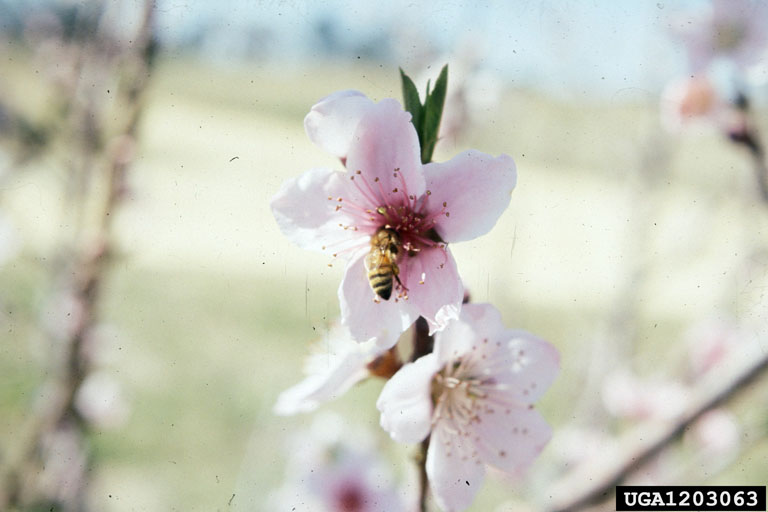 Freeze Damage in Fruit Crops - April 20, 2016 Jeff Schalau, Agent, Agriculture & Natural Resources University of Arizona Cooperative Extension, Yavapai County This year’s February weather was warmer than average causing deciduous fruit trees to bloom earlier than normal. Spring is officially here, but we could still experience cold temperatures that could damage or destroy a fruit crop. Learning to understand the critical temperatures for each fruit type and the most vulnerable stages of development will help you monitor your fruit crop and predict its seasonal needs such as fruit thinning, fertilization, and time needed to harvest and preserve your crop. Freeze damage to deciduous fruit crops can occur when temperatures dip below 31 degrees F. However, various fruit types can withstand temperatures lower than 31 depending on the species and stage of development. The killing temperature (also called critical temperature) is defined as the temperature that buds and developing fruit can withstand for a half-hour before permanent damage occurs. Often the freeze will only damage part of the flowers such as the most developed ones or flowers in the bottom of the tree. The Verde Valley rarely loses its fruit crop to a late spring freeze, but cooler locations such as Prescott and Flagstaff often do. Peach, apricot, nectarine, cherry, and plum are stone fruits. Stone fruit flowers contain a single pistil which is the female flower part that becomes the fruit. Flower buds can be cut open and inspected to determine if they were frost damaged before opening. Stone fruit flowers can be torn open to inspect for black pistils. Flowers having black pistils indicate the flower has been killed and fruit will not form. Today, wireless thermometers are readily available and inexpensive. The receiver can be placed in a convenient location to monitor low temperatures during critical periods while sensors can be placed outdoors near the crop plants. Most of these thermometers have alarms that can be set when temperatures dive to user defined levels. Most are able to have multiple sensors that can be located in various locations and monitored from a single receiver. Apricots, peaches, plums, and sweet cherries in the pre-flowering stage have a killing temperature of 23 degrees F. This rises to 27 degrees F in full bloom and 30 degrees following bloom. Sour cherries in the pre-flowering stage have a killing temperature of 15 degrees F which rises to 28 degrees in full bloom. Apples and pears are pome fruits and have a different structure than stone fruits. In apples, the fruit buds are really small shoots with flowers and leaves. In apples the flower in the center of the flower cluster is the oldest and has the potential to be the largest fruit. This central flower is called the king bloom and is the most desirable of the flowers in the cluster. The king bloom is also the most advanced and therefore the most likely to be killed in a frost. Several weeks after a killing frost it is not unusual to see the side blooms larger than the king bloom this means that the king bloom was killed earlier in the spring. Another difference between apples and stone fruits is that the pistil is buried in the floral cup at the base of the flower and not exposed above it as in stone fruit. This means that it is often necessary to tear the flower apart to see if the center of the flower is brown or black. When checking apples for frost damage look at the king and side blooms separately. Apples in the pre-flowering stage have a killing temperature of 16 degrees F while pears can only tolerate 18. Apples and pears in full bloom have a killing temperature of 29 degrees F. Stone fruits typically have a lower chilling requirement and bloom earlier. Therefore, in areas prone to late spring frosts, yearly crops are less reliable. Apples and pears often bloom later and can withstand slightly lower temperatures providing more reliable crops from year to year. Although temperature minimums can predict damage, there are often warmer zones within the tree’s canopy that allow some fruit to remain viable following otherwise killing temperatures. Diligent fruit growers also employ frost protection strategies such as covering trees with or without a heat source underneath it such as incandescent light bulbs. Visit the online edition for more information. Follow the Backyard Gardener on Twitter – use the link on the BYG website. If you have other gardening questions, call the Master Gardener help line in the Camp Verde office at 928-554-8992 or e-mail us at verdevalleymg@gmail.com and be sure to include your name, address and phone number. Find past Backyard Gardener columns or provide feedback at the Backyard Gardener web site: http://cals.arizona.edu/yavapai/anr/hort/byg/.  Additional Resources Critical Temperatures for Frost Damage on Fruit Trees Utah State University Cooperative Extension extension.usu.edu/files/publications/factsheet/pub__5191779.pdf Critical Temperatures for Various Fruits Penn State Extension extension.psu.edu/plants/tree-fruit/commercial-tree-fruit-production/frost-protection-for-tree-fruit/critical-temperatures-for-various-fruits |